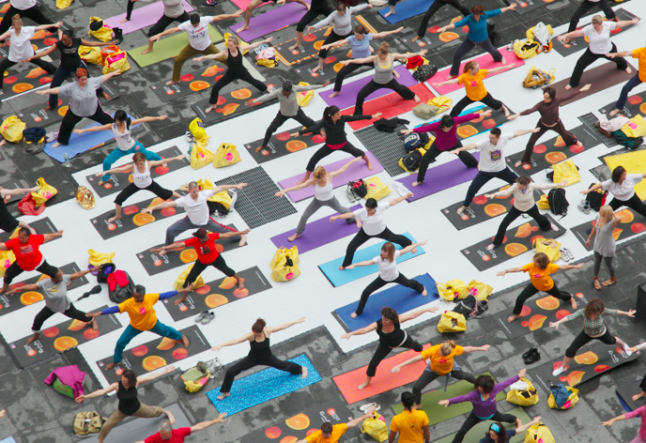caution! 3 cues to ignore in large group classes

ignore cues instructions poses large group safe yoga classes
In the article 3 Practices to Avoid Injury, we talked about a fundamental aspect of asana practice- listening to your inner teacher. But what about the outer teacher, you know the one who’s in the room actually telling you what to do? Today I want to share a couple of simple ways you can protect yourself in large group classes from some teaching cues that may not be the best for your body long term.
Protect the neck!
To headstand or not to headstand- that is the question! There is a bit of controversy over this one. The benefits of headstand can be heard shouted from the rooftops by many teachers and yogis. Alas, I am not one of them. As one of my first anatomy teachers told me- just look at the bones! The base of the spine, starting in the pelvis, is lovely and large and then the vertebrae get progressively smaller as you build up to the cervical spine (the neck). So basically it’s like balancing an upside down pyramid- not a stable idea. There is a natural curve to the cervical spine, which we want to preserve, protect and keep spacious. Compression of this area is a natural part of a stressful modern life- adding to compression rushing into and out of a headstand is not ideal.
I DO believe that there is a place for this pose, I DO NOT believe that place is in the last 3 minutes of a 60 minute vinyasa class without the proper strength, preparation and/or guidance. As ALWAYS- turn toward your inner teacher- what does he/she say?
Some other places I avoid adding stress to the neck-
Plow Pose: I do not do this pose nor ever teach it without padding
Shoulder Stand: I do not do this pose nor ever teach it without padding
Fish Pose: the common counter for Plow and Shoulder stand, most often it’s best to skip this one in favor of a lengthening Locust pose
Watch Your Back
A delicious end to most vinyasa classes involves a back bending series- ex. 3 Bridge Poses. If during this series you are instructed to hug the knees into the chest after every backbend- SKIP IT. It is a lot for our already stressed and compressed low backs to do so much back and forth. Allowing the feet to rest on the floor with bent knees is a much healthier resting space between backbends. Once all backbends are complete, release the area with a counter pose of knees into the chest or even Happy Baby.
Other places to Watch your Back:
Camel Pose: Often a Child’s pose is instructed between Camel sets. Simply sitting on your heels in Virasana is sufficiently restful.
Full Wheel: Same idea as with Bridge Pose. Rest safely with the sacrum on the floor, knees bent.
Dancer Pose: Rest in Tadasana, breathing and finding length through the whole spine. Skip drawing the knee into the chest
Knees Please
The knee is a very interesting and special joint. Unlike many of the other joints in the body, the knee really only does one thing happily- flex (ie bending). We try to make it do other things and it lets us know eventually how much it doesn’t like that by starting to ache and eventually with pain.
How do we avoid that? Well, it means most of us need to avoid or move MINDFULLY into some of those yogi classics like Lotus and Cow Face Pose. The key here is to move with your inner teacher and ALWAYS make sure your knee is tracking over your second toe. Unless you have tibular torsion. That’s when the bone structure doesn’t allow for the classic alignment.
Not sure which camp you fall into? Try this: Stand in front of a mirror with your knees bare. One at a time pick up your toes and rotate the knee till it is pointing directly forward then place the foot back down on the floor. Look in the mirror- if you drew a straight line from the center of your knee down to the floor would you hit your second toe? If “yes” then cool! Classic alignment works for you. If “NO” then note that too, no judgment, just always work with a centered knee and allow the foot to rotate accordingly.
Other places to watch those Knees Please:
Lunge poses: Padding- if it hurts to have your knee on the floor- then pad it! I have seen teachers scold students for this one, but in my experience, if it hurts- it’s no good. (Remembering of course that pain and discomfort are not the same thing!)
Full Pigeon: (The variation where we encourage the forward shin parallel to the front edge of the mat.) ALWAYS keep the foot flexed to ensure the movement is coming from an external rotation of the hip and NOT pulling on the knee ligaments.
Warrior 2: A classic place where hip tightness likes to steal movement from the knee. This is a great place to play with the knee-toe alignment from the exercise above!
Our teachers are our guides. They hold space for us to encounter our inner teacher and sometimes that means allowing us a space to hold firm to our boundaries and say “No” to an offering that doesn’t feel right. Listen to your body. Listen to your inner teacher. If you have questions- Ask! If you don’t have a regular teacher you trust- seek one out, that is also a sign of the progress of your practice! Join me next week as I conclude this series on staying safe in large group classes.
If you have any questions please feel free to Nicole directly contact@yoga216.com